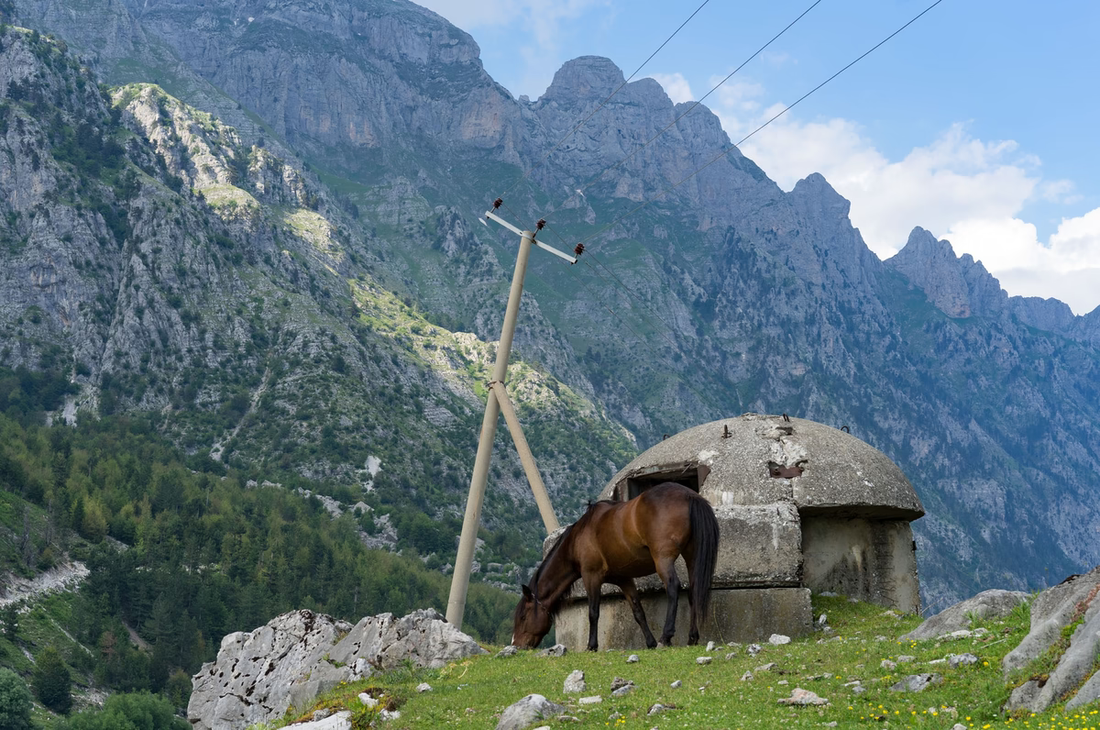
Discover Albania's Communist Era History
A Tale of Ambition, Isolation, and Exodus
Albania, a small country with a rich history, underwent a dramatic transformation during its communist era, a period marked by ambitious infrastructure development, strict ideological adherence, and eventual turmoil leading to mass migration.
The Dawn of Communist Albania
After World War II, Albania found itself under a communist regime. The government, inspired by Marxist-Leninist philosophy, embarked on a journey to reshape the country. The focus was on building a self-reliant, socialist state. This period saw significant infrastructure development:
-
Dams and Electrification: To bring electricity to all villages and power the production industry, the government erected the power grid, built power stations & towers and constructed dams, significantly boosting electricity production and distribution.

Fierza Dam (Koman Lake) - construction began in 1970.
-
Roads and Railways: A network of roads and railways was developed, connecting remote areas and fostering internal mobility. This facilitated transportation of goods and people across the country and helped further the development of heavy industries such as oil & gas, chemical, steel and machineries manufacturing. Many talented engineers received education in Russia, USSR at the time. Ironically, after the fall of the regime, the steel railroads were stolen and sold for scrap metal and most train wagons were abandoned. Nowadays, Albania offers limited train transportation.

-
Agricultural Reforms: Swamps were drained and terraced farming was introduced, revolutionizing agriculture. Arable land was concentrated in the hands of the state and private property was abolished. Albania was the first country in the world to become an Atheist state, after practice of religion was declared illegal and most churches & mosques were transformed into barns for livestock.

-
Military & National Army: The regime also focused on strengthening the military, ensuring Albania was a force to be reckoned with in the region. Albania possessed 4 Russian submarines in active operation. Bunkers were built all across the country to protect in case of a possible invasion. The reality of war was present after WW2 and throughout the Cold War, therefore the state invested heavily in arms production as well.

Initially, these developments painted a picture of a flourishing Albania, marching confidently towards self-sufficiency and modernization.
The Cracks Begin to Show
However, the sheen of progress soon began to tarnish. Albania's international relations, especially with major communist states like the Soviet Union and later China, started to deteriorate. The Albanian leadership's strict adherence to what they perceived as the true socialist philosophy of Marx and Engels led to ideological rifts. Albania found itself increasingly isolated on the global stage.
The Downfall and Its Aftermath
The rigid and isolationist policies of the communist regime eventually led to economic and social stagnation. The 1980s and 1990s were particularly turbulent:
- Student Protests: The first cracks appeared with student-led demonstrations, signaling widespread discontent with the regime.
- Shift in Regime: The communist stronghold began to weaken, paving the way for a new political landscape.
-
Civil War: The transition was far from smooth. Albania descended into chaos, culminating in a devastating civil war in the late 1990s.

In the mid-1990s Albania was adopting a free market economy, after decades of a state planned economy. The rudimentary financial system soon became dominated by Ponzi Schemes, and even government officials endorsed a series of pyramid investment funds.
By January 1997, the schemes, many of which were fronts for money laundering and arms trafficking, could no longer make payments, which led to their collapse. By then, the number of investors who had been lured by the promise of getting rich quick grew to include two-thirds of Albania's 3 million population. It is estimated that close to $1.5 billion was invested in companies offering monthly interest rates ranging from 25%–100%, while the average monthly income in the country was around $80. A significant number of Albanians had sold their homes to invest, and emigrants working in Greece and Italy transferred additional resources to the schemes.

The collapse of these schemes left many people in financial ruin, causing a civil war to erupt. Armed clans blamed the corrupt politicians and foreign intelligence agencies for being involved in these nation-spread "Get Rich Quick Schemes" and gang wars spread out. People started looting weapon depots, stealing guns, ammunitions and tanks from police headquarters and army barracks. Treasury of the state deposits (gold ingots & banknotes) were robbed. The national army and police were dissolved and the situation required international intervention.
The Great Exodus
Perhaps the most poignant chapter in this period was the mass migration of Albanians. Desperate for a better life, thousands fled the country:
-
Voyage from Vlora: In dramatic scenes, people crowded onto ships in the port city of Vlora, seeking refuge across the Adriatic and beyond.

- Global Albanian Diaspora: Today, a significant number of Albanians live abroad, with large communities in countries like Italy, Greece, UK, the United States, Germany, and Switzerland. Fun Fact: There are more Albanians living abroad than there are residing in the country.
Reflections on a Turbulent Era
The communist era in Albania is a complex tapestry of ambitious development, ideological rigidity, and eventual social and economic collapse. It serves as a poignant reminder of the perils of isolationism and the human cost of political upheaval. As Albania continues to rebuild and redefine itself on the world stage, the lessons from this era remain deeply ingrained in the national consciousness and the lives of the Albanian diaspora worldwide.
